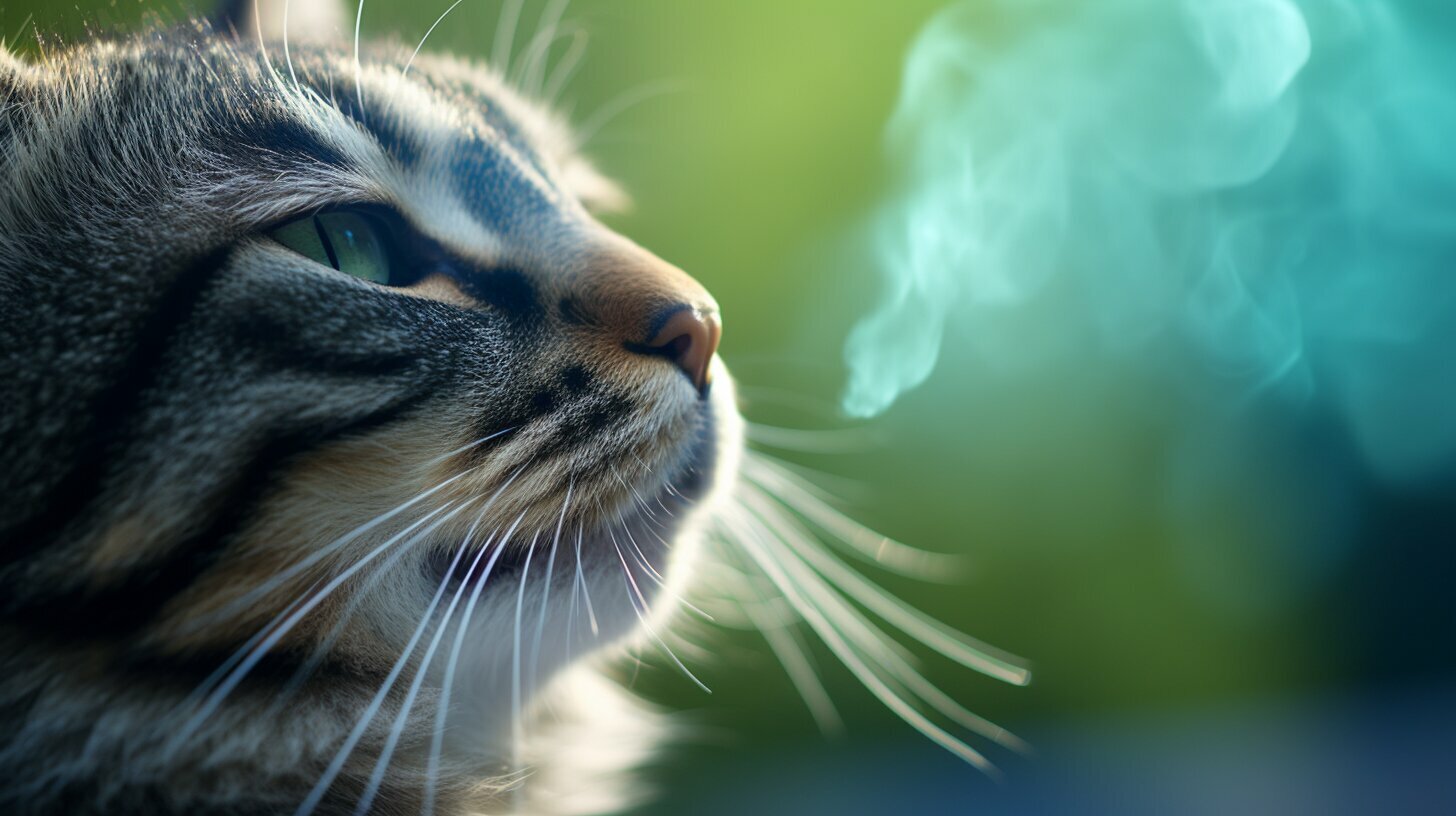Unveiling the mystery: Why do cats sniff butts?
Have you ever wondered why cats engage in the peculiar behavior of sniffing each other’s butts? While it may seem strange to us humans, this behavior is an essential part of feline communication and gathering information about other cats. Cats rely heavily on their sense of smell to navigate their world, and sniffing butts is just one way they use this powerful sense to understand their surroundings.
Cats have an incredibly advanced sense of smell, with their noses containing 45 to 80 million scent receptors. In comparison, humans only have around 5 million scent receptors. Additionally, cats have a specialized organ called Jacobson’s organ, which further enhances their sense of smell and allows them to detect specific chemical substances.
When cats sniff each other’s rear ends, they can gather a wealth of information. Through the scent glands located in their anal area, cats can determine whether another cat is a friend or a foe, their mood, and even their health. This behavior is similar to how humans use handshakes or hugs to greet and exchange information with one another.
The act of sniffing butts also serves a social purpose among cats. It is a way for them to establish dominance and set the tone of their relationship. By exchanging scents, cats can communicate their social standing and build social bonds with one another.
It’s important to understand that butt sniffing is a natural and instinctual behavior for cats. Interrupting this behavior can cause stress and confusion between cats. So, while it may be strange to us, it is an integral part of their communication toolkit.
Key Takeaways:
- Cats sniff each other’s butts as a form of communication and gathering information about other cats.
- They have a highly advanced sense of smell, with 45 to 80 million scent receptors.
- Cats also have an additional organ called Jacobson’s organ, which enhances their sense of smell.
- Sniffing butts allows cats to determine social standing, mood, and health of another cat.
- This behavior is a natural and instinctual way for cats to communicate and exchange information.
Understanding feline communication through scent
Cats have a remarkable ability to communicate through various forms, and one of the most fascinating methods is through their sense of smell. Their noses contain an astonishing number of scent receptors, ranging from 45 to 80 million, which far surpasses our mere 5 million. This heightened sense of smell allows cats to gather an incredible amount of information about their surroundings and other feline companions.
When it comes to feline communication, scent plays a crucial role. Through their sense of smell, cats are able to determine if another cat is a friend or foe, their mood, and even their overall health. This is why you may notice your cat intently sniffing the rear end of another cat – they are gathering valuable information.
Cats also have an additional organ called Jacobson’s organ, located in the roof of their mouth, which enhances their sense of smell and detects specific chemical substances. When a cat sniffs another cat’s rear end, they are utilizing this organ to analyze the pheromones and other scents present. It’s their way of communicating and exchanging information in their own chemical language.
| Sniffing Behavior | What Cats Can Learn |
|---|---|
| Sniffing a friendly cat’s butt | Recognizing a familiar scent and reinforcing bonding |
| Sniffing an unfamiliar cat’s butt | Establishing dominance and determining social standing |
| Sniffing a sick or stressed cat’s butt | Identifying potential health issues or emotional distress |
It’s important to note that interrupting or discouraging this behavior can cause stress between cats, as it is a natural and instinctual behavior for them. Just as humans shake hands or hug when meeting someone, cats use their sense of smell to communicate and exchange information. By allowing them to engage in this behavior, we are respecting their natural instincts and providing them with the means to fully understand their surroundings and fellow feline friends.
The power of a cat’s nose: Olfactory superiority
With their noses containing tens of millions of scent receptors, cats possess an extraordinary sense of smell that surpasses that of humans. This olfactory superiority allows them to gather a wealth of information about their environment, including other cats. Cats utilize their sense of smell as a vital tool for communication, marking territory, finding mates, and recognizing each other.
When it comes to cat scent marking, they are capable of leaving behind chemical substances that convey important messages to other cats. By sniffing these pheromones, cats can determine the presence of a fellow feline, their gender, reproductive status, and even their emotional state. This chemical exchange plays a crucial role in their social behavior and helps establish hierarchies within cat communities.
In addition to scent marking, cats also rely on their sense of smell to identify potential mates and assess their health. By sniffing each other’s rear ends, cats can detect pheromones that indicate a cat’s reproductive status and overall well-being. This olfactory information aids them in making choices for potential interactions and helps avoid unwanted conflicts or diseases.
A cat’s nose: A complex and sophisticated organ
Behind a cat’s remarkable smelling abilities lies the secret of Jacobson’s organ. This specialized olfactory organ, located in the roof of their mouth, functions by pulling air over the vomeronasal organ. This allows cats to detect and analyze specific chemical substances that are not detected by regular olfactory receptors. When a cat sniffs another cat’s rear end, they are using this organ to gather even more detailed information about the other feline.
In conclusion, the act of cats sniffing each other’s rear ends serves as a powerful form of communication and information gathering. Their exceptional sense of smell, combined with the specialized capabilities of Jacobson’s organ, allows them to exchange vital messages and establish social bonds. Understanding this natural behavior is crucial for cat owners and cat enthusiasts to ensure the well-being and harmony of these fascinating creatures.
| Key Points: |
|---|
| – Cats have a highly advanced sense of smell with tens of millions of scent receptors |
| – They use their sense of smell to communicate, mark territory, find mates, and recognize each other |
| – Sniffing each other’s rear ends allows cats to gather information about gender, reproductive status, and emotional state |
| – The Jacobson’s organ enhances their sense of smell and allows them to detect specific chemical substances |
| – Sniffing butts is a natural behavior for cats and plays a crucial role in their social interactions |
Jacobson’s Organ: The Secret Behind Cat Sniffing Behavior
Alongside their impressive sense of smell, cats have a specialized organ called Jacobson’s organ, which plays a significant role in their sniffing behavior. This organ is located in the roof of their mouths, and it allows cats to detect and analyze specific chemical substances. When a cat sniffs another cat’s rear end, they are actually collecting valuable information about their scent and overall well-being.
Jacobson’s organ is linked to the vomeronasal system, a part of a cat’s olfactory system that is responsible for detecting pheromones. Pheromones are chemical signals that cats use to communicate with each other. When a cat sniffs another cat’s rear end, they are able to pick up on these pheromones and gather information about the other cat’s social status, health, and mood.
To better understand this behavior, imagine a cat’s sense of smell as a superpower. While we might think of butt sniffing as odd or distasteful, it is completely normal for cats. In fact, cats rely heavily on scent-based communication. Sniffing butts allows them to establish dominance, mark territory, and reinforce social bonds. It’s their equivalent of a handshake or a hug when meeting someone new.
| Key Points |
|---|
| Cats have a specialized organ called Jacobson’s organ, which enhances their sense of smell. |
| Jacobson’s organ is linked to the vomeronasal system, enabling cats to detect pheromones. |
| Sniffing butts is a natural and instinctual behavior for cats, allowing them to gather valuable information about each other. |
| Butt sniffing helps cats establish dominance, mark territory, and reinforce social bonds. |
| Interrupting this behavior can cause stress and disrupt communication between cats. |
Decoding information: What cats can learn from sniffing butts
When cats engage in butt sniffing, they are actually exchanging crucial information about each other, such as their social status and overall well-being. This seemingly strange behavior is an essential part of feline communication and plays a significant role in their interactions. Cats have an incredibly advanced sense of smell, with their noses containing 45 to 80 million scent receptors, allowing them to detect and decipher chemical substances that humans could only dream of.
Sniffing each other’s rear ends allows cats to gather a wealth of information. They can determine whether the other cat is a familiar friend or a potential foe. By analyzing the scents left behind, they can gauge the mood and health of the other cat. Cats can also learn about the social hierarchy, determining who is dominant and who is submissive. This exchange of information helps in establishing and maintaining harmonious social bonds within their feline community.
Butt sniffing is a natural and instinctual behavior for cats, much like how humans shake hands or hug when meeting someone. It is a way for them to communicate and exchange information through chemical signals. Interrupting or discouraging this behavior can cause stress and disrupt the delicate balance of their social interactions.
In the world of cats, the sense of smell is their primary mode of communication. They utilize scent marking to claim territories, find potential mates, and recognize their fellow felines. Sniffing each other’s rear ends is an integral part of this chemical communication tool. Interestingly, this behavior is not limited to encounters with unfamiliar cats. Even cats who are already acquainted may engage in butt sniffing as a way to update their information and reinforce their bond and communication.
| Key Takeaways: |
|---|
| When cats sniff each other’s rear ends, they exchange crucial information about social status and overall well-being. |
| Cats have an advanced sense of smell, with 45 to 80 million scent receptors in their noses. |
| Sniffing butts helps cats determine social hierarchy, mood, and health of the other cat. |
| This behavior is a natural and instinctual part of feline communication and should not be discouraged. |
Butt Sniffing Etiquette: Establishing Dominance and Social Bonds
Butt sniffing is not just a random behavior; it serves as a way for cats to establish hierarchy and form social connections with one another. When cats encounter each other, they rely heavily on their sense of smell to gather information and determine how they should interact. By sniffing each other’s rear ends, cats can assess the scent and pheromones left behind, allowing them to gather insights into the other cat’s identity, social standing, and overall well-being.
This act of olfactory communication is a key aspect of feline etiquette, providing a platform for cats to establish dominance and set the tone for their relationship. When a cat sniffs another cat’s butt, they are essentially exchanging information and gaining a better understanding of their position within the social hierarchy. This helps prevent unnecessary conflicts and promotes a more harmonious coexistence among cats.
As cats sniff each other’s rear ends, they are engaging in a behavior deeply ingrained in their instincts. Similar to humans shaking hands or hugging when meeting someone, butt sniffing is a natural and necessary part of feline communication. It is through this behavior that cats forge social bonds and maintain relationships with one another.
Understanding the Reactions
It is important to note that the reactions of cats to butt sniffing can vary based on their personality and the dynamics of their relationship with the other cat. Some cats may display a more passive approach, allowing the other cat to sniff without much resistance. Others may respond more assertively, asserting their dominance or indicating that they are not in the mood for interaction.
To interrupt or discourage this behavior can cause stress and confusion between cats. It is best to let them engage in their natural communication rituals, respecting their boundaries and allowing them to establish their social dynamics without intervention.
| Benefits of Butt Sniffing: |
|---|
| Establishes dominance hierarchy |
| Facilitates the formation of social bonds |
| Provides vital information about each other’s identity and state of health |
| Promotes harmonious coexistence among cats |
Sniffing beyond strangers: Updating information and reinforcing bonds
Sniffing butts isn’t limited to unfamiliar cats; cats may also engage in this behavior with their known counterparts to maintain their communication and reinforce their connection. While it may seem peculiar to us humans, this behavior serves an essential purpose in feline social dynamics. When cats interact through butt sniffing, they exchange valuable information encoded in the scent of their anal glands. This enables them to stay updated on each other’s health, reproductive status, and emotional state.
Through this unique form of communication, cats can strengthen their bonds and reinforce their social hierarchy. The scents exchanged during butt sniffing provide cats with an intimate look into the lives of their feline companions. It’s like a secret language that only they can understand, allowing them to navigate their social interactions more effectively.
Just as humans engage in conversations to catch up and reinforce their relationships, cats rely on butt sniffing to maintain a connection with their familiar feline friends. It’s a way for them to confirm their familiarity, reaffirm their trust, and establish a sense of belonging. By regularly updating their information through butt sniffing, cats can adapt their behavior accordingly and respond to any changes in their known counterparts’ lives, ensuring a harmonious and balanced feline community.
Table: Common Information Exchanged Through Butt Sniffing
| Information Exchanged | Meaning |
|---|---|
| Health status | Determines if the cat is ill or in good health |
| Reproductive status | Indicates if the cat is in heat or neutered/spayed |
| Emotional state | Provides insight into the cat’s mood and stress levels |
| Identification | Helps cats recognize familiar individuals in their social group |
So, the next time you see cats engaging in this seemingly peculiar behavior, remember that it’s their way of maintaining communication and reinforcing their social bonds. Respect their natural instincts and allow them to sniff each other’s rear ends, as it plays an essential role in their feline world.
Conclusion
The act of cats sniffing butts is a natural and fundamental aspect of feline communication, enabling them to gather vital information and establish social dynamics. Cats have an incredibly advanced sense of smell, with their noses containing 45 to 80 million scent receptors. This exceptional olfactory system allows them to detect specific chemical substances and decipher important details about other cats.
When cats sniff each other’s rear ends, they are able to determine a wealth of information, including whether the other cat is a friend or foe, their mood, and even their overall health. This behavior is comparable to how humans shake hands or hug when meeting someone new. For cats, it is an instinctual way to build connections and understand the world around them.
Furthermore, cats possess an additional organ called Jacobson’s organ, which enhances their sense of smell and plays a crucial role in butt sniffing behavior. This organ helps them analyze the specific chemical compounds released by other cats, providing even more precise information for communication.
Butt sniffing is not limited to unfamiliar cats; cats may also engage in this behavior with cats they already know. By doing so, they update their information and reinforce their bond and communication with familiar feline companions. It is a way for them to stay connected and maintain social harmony.
In conclusion, the act of cats sniffing butts may seem peculiar to us, but it is an essential part of their communication repertoire. Understanding and respecting this behavior can help foster healthy interactions and relationships between cats, creating a harmonious environment for all feline companions.
FAQ
Why do cats sniff each other’s rear ends?
Cats sniff each other’s rear ends as a form of communication and to gather information about other cats. It helps them determine if a cat is a friend or foe, their mood, and their health.
How do cats sniff rear ends?
Cats have a highly advanced sense of smell with 45 to 80 million scent receptors in their noses. They also have an additional organ called Jacobson’s organ, which enhances their sense of smell and detects specific chemical substances.
Is butt sniffing a natural behavior for cats?
Yes, butt sniffing is a natural and instinctual behavior for cats. It is similar to how humans shake hands or hug when meeting someone. Cats use their sense of smell to communicate and exchange information, and butt sniffing is part of their chemical communication tool.
Can interrupting butt sniffing cause stress between cats?
Yes, interrupting a cat while they are sniffing another cat’s rear end can cause stress and disrupt their communication. It’s best to let cats engage in this behavior as long as it’s safe and not leading to aggression.
Do cats only sniff the butts of unfamiliar cats?
No, cats may also sniff the butts of cats they already know to update their information and reinforce their bond and communication.
How do cats react to butt sniffing?
The reactions of cats to butt sniffing can vary based on their personality and relationship with the other cat. Some cats may be more relaxed and accepting, while others may be more guarded or defensive.






